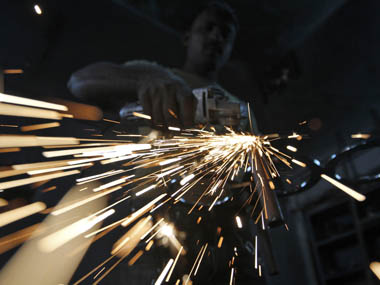Maybe, although it would be sensible to be a little cautious right now.
There’s no denying that in recent weeks, the news from the economy has been getting slightly better.
One of the most upbeat economic data came yesterday: after a shocking contraction in industrial output in October, the Index of Industrial Production (IIP) surged in November by 5.9 percent from a year ago.
The jump was led by an improvement in manufacturing, which accounts for about 76 percent of the IIP, and electricity generation.
Of course, a large portion of the improvement in November IIP data can be explained by higher festival season demand , so we’ll have to wait for another month or two to see whether this trend holds. For now, most experts are cautious.
[caption id=“attachment_180798” align=“alignleft” width=“380” caption=“India’s DecemberPMI rose to 54.2 even as food prices for the week ending 31 December declined by a further 2.9 percent.Reuters”]
 [/caption]
[/caption]
“Despite the surprise performance of IIP in November 2011, we believe that IIP growth during the remaining months of this fiscal, though positive, would remain below 5 percent,” Crisil said in a note.
Still, that’s better than no growth at all.
The signs of recovery?
Early signs of India’s improving manufacturing sector came in December itself , when the HSBC Markit Purchasing Managers’ Index for that month rose to 54.2 - a six-month high and the largest monthly jump since 2009. The services PMI also rose the fastest in the same period. (A reading above 50 indicates expansion; anything below, contraction).
Impact Shorts
More ShortsOther encouraging signs: food prices for the week ended 24 December declined 3.36 percent - the first time in six years. Prices for the next week ending 31 December were also lower by 2.9 percent .
Food prices have played a starring role in stoking overall inflation. With prices declining sharply - and expected to continue declining in the near term (despite droughts in some parts of the country) - overall inflation should also start falling.
Some experts believe the wholesale price index, which has hovered above 9 percent for most of 2011, could finally slip to around 7.5 percent in December. Inflation data will be out on Monday.
That will cause consumers and business to breathe a huge sigh of relief, as economy has been hobbled by high prices and high interest rates. Indeed, now the bets are increasing that Reserve Bank of India governor D Subbarao will start cutting rates by March. (There is a policy meeting on 24 January, but most economists believe a rate cut then may be premature.)
Another piece of good news: even the fickle rupee seems to be behaving itself - for now. Concerted intervention by the RBI in the foreign exchange market, the introduction of measures such as freeing the rates on non-resident Indian (NRI) deposits, allowing foreign private investors to participate directly in Indian stock markets, as well as stronger inflows into local debt have helped calm the currency, which hit a near six-week high of 51.61 against the dollar earlier this week.
While a growing current account deficit (the gap between exports and imports, including service payment flows) will always mean there will be higher demand for dollars than supply in the country, at least the panic seems to have subsided.
Even indirect tax collections have improved: according to this Firstpost story, indirect tax collections jumped 16 percent during April-December, mainly driven by higher service tax payments. Services account for 60 percent of the economy.
Put all the facts together and you get a picture of an economy that maybe slowly starting to mend.
Worst may be over, but a long slog ahead
They also speak volumes about the economy’s resilience since most of the improvements have taken place, despite the government’s policy paralysis.
Nevertheless, it would be foolish to expect things to get much better very soon. Interest rates are still very high and investment demand remains extremely muted. Credit demand remains subdued. Corporate margins and profit growth continue to remain under pressure. The rupee can still gyrate and send inflation soaring again.
So, even if the worst is behind us, most economic data will likely stay inside the edge of negative territory for a while.
Indeed, GDP growth, which slowed to 6.9 percent in the September-ending quarter last year, is likely to remain sluggish throughout 2012.
There is one possible plus: the government finally seems to waking up to doing something to revive the economy. About time, too. “We need to build on this (IIP) recovery with a stronger performance of capital goods and, therefore, investments. For that, we need to take some pro-active measures, about which I cannot comment right now,” Finance Minister Pranab Mukherjee is quoted as saying by Business Standard .
For now, we can at least take comfort in the fact that the economy has defied several odds and fought to grow.
That, in itself, is no mean feat.
)